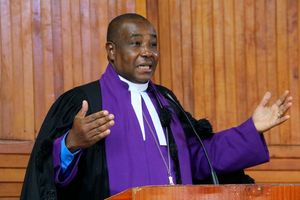Premium
Koome must abandon appeasement of Executive, act on rogue judges

Chief Justice and and President of the Supreme Court of Kenya Martha Koome.
What you need to know:
- Given what we know about this Executive, Koome’s optimism about forging a cordial, collaborative relationship of mutual consideration and big-happy-family is painfully naïve.
- This executive is uninterested in the economies of forging or sustaining working relationships with institutions.
The unstated upshot of my argument last week was that Hon. Martha Koome’s posture affirms the executive thesis that effectively, the Chief Justice’s job description is a facsimile of that hideous innovation of the Building Bridges Initiative (BBI): the judiciary ombudsman.
The role had been mooted to put the fear of God in the entire judicial sector, thus ensuring total Executive control.
After the BBI floundered in unforgiving political and legal straits, an unrelenting Executive sought other avenues to its destination.
Given what we know about this Executive, Koome’s optimism about forging a cordial, collaborative relationship of mutual consideration and big-happy-family is painfully naïve.
So what exactly do we know about this executive?
First, that it is uninterested in the economies of forging or sustaining working relationships with institutions.
Instead, it prefers to embed individual agents to accomplish specific tasks, and redeploy them afterwards.
A great many strategic debacles of this administration are directly attributable to this institutional blind spot.
The second thing is that the Executive thinks other arms of government are its extensions, in the manner that a tool may be considered an extension of a workman’s hand.
In this scheme, the Executive is the deliberative, intent-forming quarter of government, which enlists Parliament and the courts to formulate appropriate instruments for the accomplishment of its objectives.
Nimble appendage
Understandably, therefore, it finds the idea of independent organs repugnant, and anything short of a nimble appendage of the Executive, preposterous.
It has therefore been a long-standing strategic priority for the Executive to arrest the burgeoning independence of the Judiciary.
Hence, Koome’s overtures to collaborate with the Executive and defer to the presidency as some governmental father figure are a most needful invitation for a hell-for-leather stampede to overrun institutional boundaries and despoil the Judiciary.
The swagger with which Office of the President operatives parade the Chief Justice, smugly unbothered by their emphatic contempt for court orders, indicates strong confidence in this regard.
As a stakeholder of the Judiciary, the Executive has been fairly ineffective.
The Attorney-General’s shambolic travails on behalf of the Republic are a case in point.
Woeful failure
Executive shortcomings are, however, by no means limited to this woeful failure.
Agencies with coercive potential have been annexed by the Executive.
As a result, decisions to prosecute are taken on the basis of extraneous considerations, often connected with politics.
Seemingly, it is decreed that humiliating arrest and arraignment must be levied expeditiously against the spurned, while the same adversities must be stayed or abandoned altogether against the appropriately aligned.
In other words, accountability is merely just deserts for the disgraced, and impunity, the boon of the favoured.
The apportionment of this perverse patronage is parsimoniously overseen by the Executive.
Many a time, independent judges throw a spanner in the works, infuriating a baleful Executive.
Recent disclosures by a top Nairobi politician demonstrate that judicial corruption has advanced beyond mere payment of bribes to the entrenchment of powerful business networks informally mediating the hearts of the Executive and the Judiciary.
The existence of this nefarious complex implies that litigation now runs on two tracks: the formal lawyering before courts, with a clear demarcation between the bench and the bar, and a second domain where judges represent amenable litigants before their colleagues and negotiate favourable decisions for them while their agents channel bountiful compensation.
Parallel moral universe
In this parallel moral universe, values are inverted.
“Bad” judges do not keep their end of the corrupt bargain and "trust” is the basis of these iniquitous transactions.
A bribe was returned by a judge who found the law unassailable.
Evidently, the robust independence of the post-2010 Judiciary insulates an ethically diverse enclave.
Many excellent judges resist pressure and bribes, always deciding matters on the basis of the law, but there are various shades of rogue judges who only apply the law if it – incidentally – conforms to their malignant incentives.
An ombudsman’s reign of terror would rapidly convert the Judiciary into a political appendage of the Executive, astutely coordinating the two-track system of litigation for the benefit of corrupt litigants affiliated with the Executive.
To restore public confidence, it is imperative that Koome abandons the highly problematic and doomed strategy of executive appeasement, and fosters a capacity of the Judicial Service Commission to purge shady judges.
The legitimacy of the Judiciary depends on its independence and integrity, which in turn rely on the Chief Justice’s political and administrative deportment to disabuse the executive of its wicked, arrogant and contemptuous expectations.
The writer is an advocate of the High Court and a former State House speech writer.





